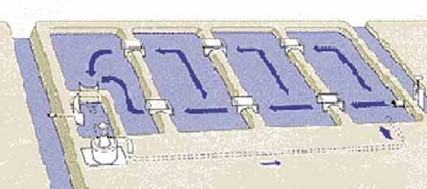Tailwater Recovery
Tailwater Recovery
Definition
A planned system to collect, store and transport irrigation tailwater for re-use.
Purpose
- Conserve irrigation water supplies through capture and re-use of the water that runs off the field
- Improve off-site water quality
How Does This Practice Work?
Runoff from irrigated land is collected, conveyed, stored and reused. This system normally includes a combination of practices and equipment that collect, convey, store and recycle irrigation runoff water for re-use. Common components include pickup ditches, sumps, pits, pumps and pipelines. A sump or pit is always needed to store the tailwater until it is redistributed in the farm irrigation system. The pits may be small or large depending on the type of recycling pump and other components of the irrigation delivery system.
All tailwater recovery systems require facilities of some kind to convey the tailwater from the storage pit to the point of reentry into the farm irrigation system. This may involve installing a pump and pipeline to return the water to the upper portion of the farm, or it may only consist of a gravity outlet to a ditch or pipeline to convey the water to a lower section of the farm irrigation system.

Where This Practice Applies and Its Limitations
Tailwater recovery systems are suitable for use on lands and facilities that are served by a properly designed and installed irrigation system, where recoverable irrigation runoff flows can be anticipated under current or expected management practices.
Collection facilities
Facilities for the collection of irrigation tailwater are an integral part of irrigation systems. These facilities may include, but are not limited to, ditches, culverts, pipelines, water control structures, land/or grade stabilization structures or other erosion control measures. These features collect and/or redirect the tailwater.
Storage facilities
Facilities are needed to store the collected water until it is redistributed in the irrigation system. Runoff volume and rate, rate of use in the irrigation system, as well as the required level of water control at the point where the tailwater is returned to the irrigation system, should be considered in determining the size of the storage facility.
Variable Flow Tailwater System
For systems where tailwater cannot be easily stored in a pit or reservoir, a Variable Flow Tailwater System may be used at the field scale. This type of system uses a small sump and a pumping plant with facilities (i.e., float valve) to vary the flow rate discharged back into the irrigation system, matching the incoming runoff.

Additional considerations applicable to improving water quality
Where additional storage is required to provide adequate retention time for the breakdown of chemicals in the runoff waters, storage facilities should be sized accordingly. Allowable retention times are site-specific to the particular chemical used. Additional storage may be required to provide for sediment deposition.
Effectiveness
Tailwater recovery systems are extremely effective in the capture and re-use of irrigation water and may improve the system irrigation efficiencies from 25 to 30 percent. Tailwater recovery systems also have a significant impact on improving water quality through trapping of sediments and the collection and re-use of runoff waters that contain nutrients and chemicals. Sediments with attached phosphorus or other nutrients and chemicals are collected, contained and may be recycled. The trapping effectiveness depends on system design and is directly related to retention times. Tailwater recovery systems can be highly effective in improving off-site water quality.
Cost of Implementing the Practice
In general, tailwater recovery systems cost will vary depending on the area serviced by the system. System cost includes earth work, pipeline installation and pump assembly. The cost of a particular tailwater recovery system can be estimated using the following prices: $1.75 per cubic yard of earth work (excavation or earth fill) plus $17.00 per foot for a 12-inch PVC high-pressure pipeline installation. Add the cost of pump and power source, if needed, to the system cost. Your local NRCS office can provide better cost estimates.
Operation and Maintenance
Periodic cleaning and re-grading of collection facilities, removal of debris from trash racks and structures, removal of sediment from traps and/or storage facilities and routine maintenance of all mechanical components will be necessary.
References
Broner, I. Tailwater Recovery for Surface Irrigation, No. 4.709. Colorado State University.
NRCS Website: http://www.nrcs.usda.gov/
NRCS Engineering Field Manual.
NRCS local field office technical guides. http://www.nrcs.usda. gov/technical/efotg
NRCS National Conservation Practices Standard (447). http://www.nrcs.usda.gov/technical/efotg
NRCS National Irrigation Guide, Part 652.
For Further Information
Contact your local soil and water conservation district, USDA-NRCS or Cooperative Extension Service office. To find your local USDA Service Center, visit https://www.nrcs.usda.gov/contact/find-a-service-center. Cost share may be available.
Current Authors
| Michele L. Reba USDA-ARS michele.reba@usda.gov |
Rodney Wright USDA-NRCS |
Previous Author
| Dennis Carmen USDA-NRCS |
Editing and Design
| Deanna Osmond NC State University |
Forbes Walker University of Tennessee |
Citation:
Reba, M. and R. Wright. 2023. Tailwater Recovery. SERA17 Phosphorus Conservation Practices Fact Sheets. https://sera17.wordpress.ncsu.edu/tailwater-recovery/
